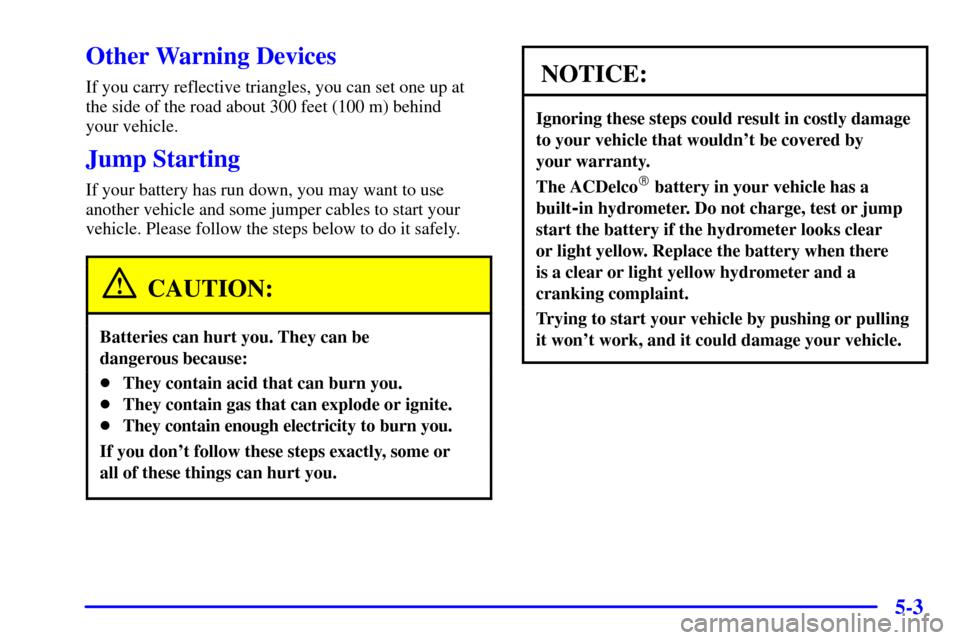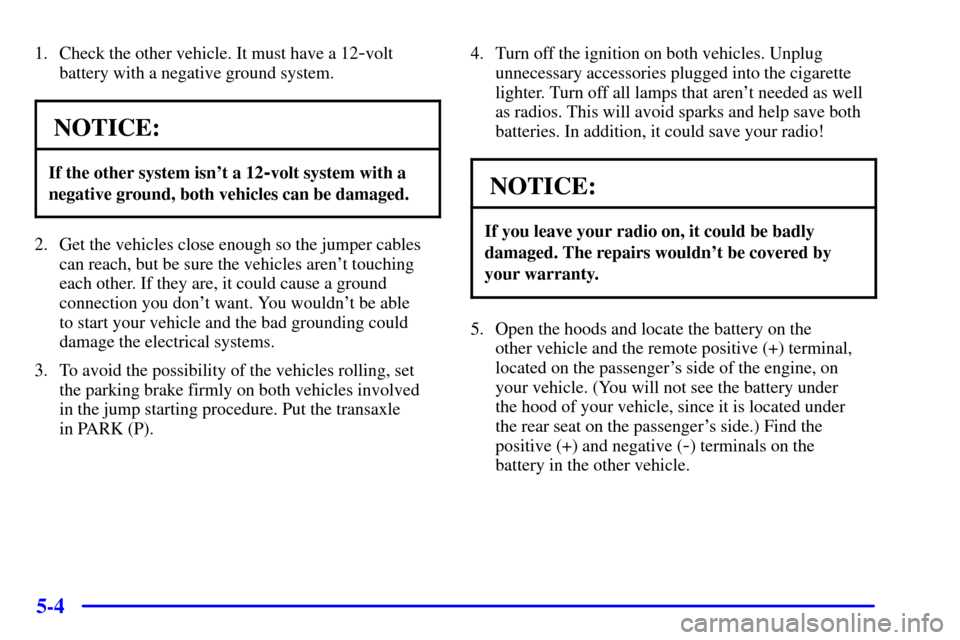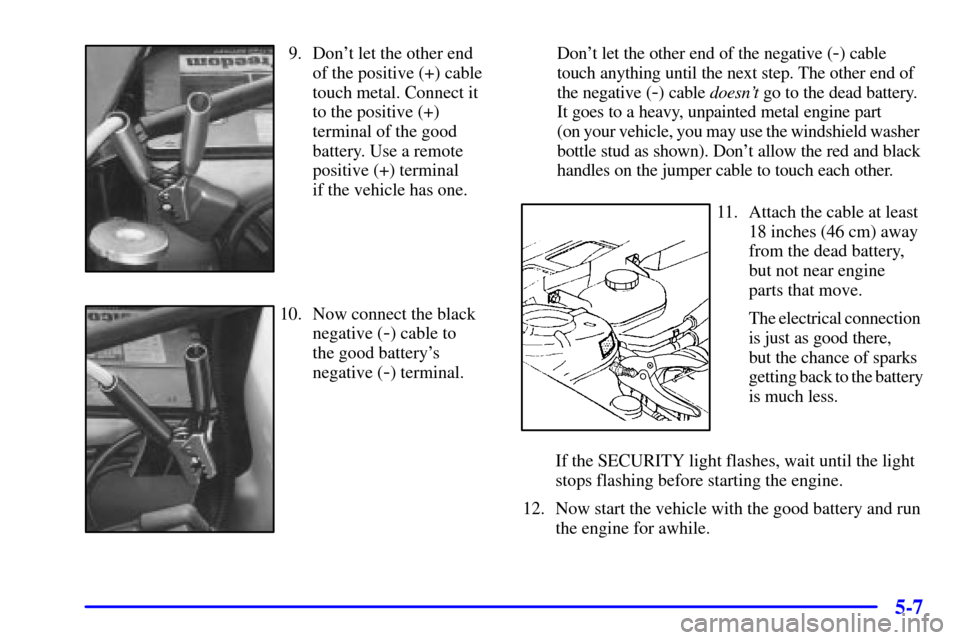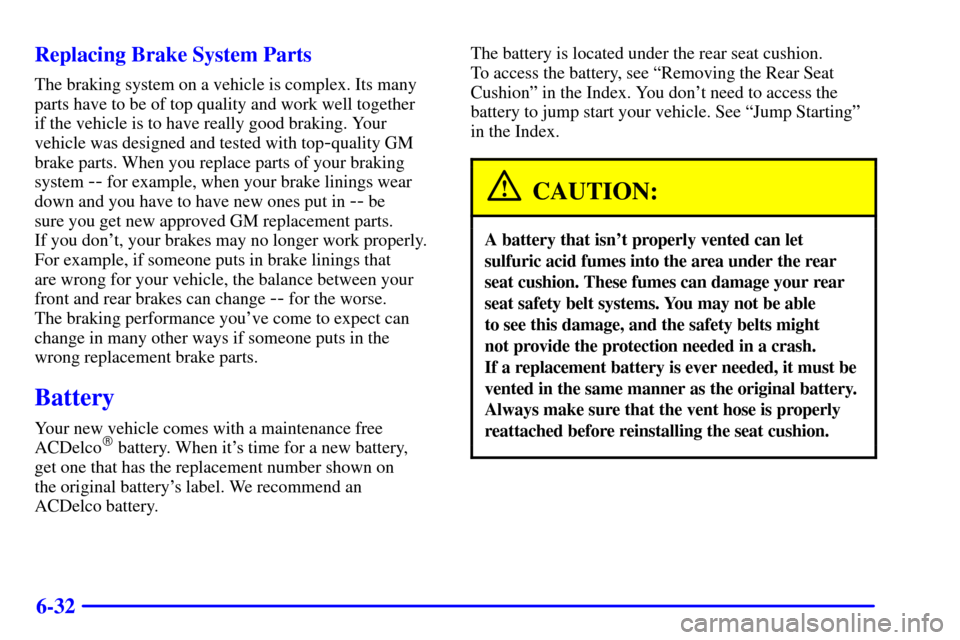Page 5 of 359
iii
Section
3
Comfort Controls and Audio Systems
Section
4
Your Driving and the Road
Section
5
Table of Contents (cont'd)
Defensive Driving
Drunken Driving
Control of a Vehicle
BrakingSteering
Driving Tips for Various Road Conditions
Loading Your Vehicle
Towing a Trailer Heating and Air Conditioning
Setting the Radio Clock
Radio/Cassette Player/CD PlayerRadio Theft-Deterrent Feature
Steering Wheel Controls (If Equipped)
Hazard Warning Flashers
Jump Starting
Towing Your VehicleEngine Overheating
Changing a Flat Tire
If You're Stuck
Problems on the Road
Page 249 of 359
5-
5-1
Section 5 Problems on the Road
Here you'll find what to do about some problems that can occur on the road.
5
-2 Hazard Warning Flashers
5
-3 Other Warning Devices
5
-3 Jump Starting
5
-8 Towing Your Vehicle
5
-9 Engine Overheating5
-12 Cooling System
5
-17 If a Tire Goes Flat
5
-18 Changing a Flat Tire
5
-27 Compact Spare Tire
5
-28 If You're Stuck: In Sand, Mud, Ice or Snow
Page 251 of 359

5-3
Other Warning Devices
If you carry reflective triangles, you can set one up at
the side of the road about 300 feet (100 m) behind
your vehicle.
Jump Starting
If your battery has run down, you may want to use
another vehicle and some jumper cables to start your
vehicle. Please follow the steps below to do it safely.
CAUTION:
Batteries can hurt you. They can be
dangerous because:
�They contain acid that can burn you.
�They contain gas that can explode or ignite.
�They contain enough electricity to burn you.
If you don't follow these steps exactly, some or
all of these things can hurt you.
NOTICE:
Ignoring these steps could result in costly damage
to your vehicle that wouldn't be covered by
your warranty.
The ACDelco� battery in your vehicle has a
built
-in hydrometer. Do not charge, test or jump
start the battery if the hydrometer looks clear
or light yellow. Replace the battery when there
is a clear or light yellow hydrometer and a
cranking complaint.
Trying to start your vehicle by pushing or pulling
it won't work, and it could damage your vehicle.
Page 252 of 359

5-4
1. Check the other vehicle. It must have a 12-volt
battery with a negative ground system.
NOTICE:
If the other system isn't a 12-volt system with a
negative ground, both vehicles can be damaged.
2. Get the vehicles close enough so the jumper cables
can reach, but be sure the vehicles aren't touching
each other. If they are, it could cause a ground
connection you don't want. You wouldn't be able
to start your vehicle and the bad grounding could
damage the electrical systems.
3. To avoid the possibility of the vehicles rolling, set
the parking brake firmly on both vehicles involved
in the jump starting procedure. Put the transaxle
in PARK (P).4. Turn off the ignition on both vehicles. Unplug
unnecessary accessories plugged into the cigarette
lighter. Turn off all lamps that aren't needed as well
as radios. This will avoid sparks and help save both
batteries. In addition, it could save your radio!
NOTICE:
If you leave your radio on, it could be badly
damaged. The repairs wouldn't be covered by
your warranty.
5. Open the hoods and locate the battery on the
other vehicle and the remote positive (+) terminal,
located on the passenger's side of the engine, on
your vehicle. (You will not see the battery under
the hood of your vehicle, since it is located under
the rear seat on the passenger's side.) Find the
positive (+) and negative (
-) terminals on the
battery in the other vehicle.
Page 255 of 359

5-7
9. Don't let the other end
of the positive (+) cable
touch metal. Connect it
to the positive (+)
terminal of the good
battery. Use a remote
positive (+) terminal
if the vehicle has one.
10. Now connect the black
negative (
-) cable to
the good battery's
negative (
-) terminal.Don't let the other end of the negative (
-) cable
touch anything until the next step. The other end of
the negative (
-) cable doesn't go to the dead battery.
It goes to a heavy, unpainted metal engine part
(on your vehicle, you may use the windshield washer
bottle stud as shown). Don't allow the red and black
handles on the jumper cable to touch each other.
11. Attach the cable at least
18 inches (46 cm) away
from the dead battery,
but not near engine
parts that move.
The electrical connection
is just as good there,
but the chance of sparks
getting back to the battery
is much less.
If the SECURITY light flashes, wait until the light
stops flashing before starting the engine.
12. Now start the vehicle with the good battery and run
the engine for awhile.
Page 308 of 359

6-32 Replacing Brake System Parts
The braking system on a vehicle is complex. Its many
parts have to be of top quality and work well together
if the vehicle is to have really good braking. Your
vehicle was designed and tested with top
-quality GM
brake parts. When you replace parts of your braking
system
-- for example, when your brake linings wear
down and you have to have new ones put in
-- be
sure you get new approved GM replacement parts.
If you don't, your brakes may no longer work properly.
For example, if someone puts in brake linings that
are wrong for your vehicle, the balance between your
front and rear brakes can change
-- for the worse.
The braking performance you've come to expect can
change in many other ways if someone puts in the
wrong replacement brake parts.
Battery
Your new vehicle comes with a maintenance free
ACDelco� battery. When it's time for a new battery,
get one that has the replacement number shown on
the original battery's label. We recommend an
ACDelco battery.The battery is located under the rear seat cushion.
To access the battery, see ªRemoving the Rear Seat
Cushionº in the Index. You don't need to access the
battery to jump start your vehicle. See ªJump Startingº
in the Index.
CAUTION:
A battery that isn't properly vented can let
sulfuric acid fumes into the area under the rear
seat cushion. These fumes can damage your rear
seat safety belt systems. You may not be able
to see this damage, and the safety belts might
not provide the protection needed in a crash.
If a replacement battery is ever needed, it must be
vented in the same manner as the original battery.
Always make sure that the vent hose is properly
reattached before reinstalling the seat cushion.
Page 309 of 359
6-33
To be sure the vent hose (A) is properly attached, the vent
hose connectors (B) must be securely reattached to the vent
outlets (C) on each side of the battery, and the vent assembly
grommet (D) must be secured to the floor pan (E).
Vehicle Storage
If you're not going to drive your vehicle for 25 days
or more, remove the black, negative (
-) cable from
the battery. This will help keep your battery from
running down.
CAUTION:
Batteries have acid that can burn you and gas
that can explode. You can be badly hurt if you
aren't careful. See ªJump Startingº in the Index
for tips on working around a battery without
getting hurt.
Contact your dealer to learn how to prepare your vehicle
for longer storage periods.
Also, for your audio system, see ªTheft
-Deterrent
Featureº in the Index.
Page 352 of 359
7-6
Each technician travels with a specially equipped
service vehicle complete with the necessary Cadillac
parts and tools required to handle most roadside repairs.
Cadillac Roadside Service� can be reached by dialing
1
-800-882-1112, 24 hours a day, 365 days a year.
This service is provided at no charge for any
warranty
-covered situation and for a nominal charge
if the Cadillac is no longer under warranty. Roadside
Service is available only in the United States
and Canada.
Cadillac Owner Privileges�
Roadside Service provides several Cadillac
Owner Privileges� at ªno charge,º throughout
your 2000 Cadillac Warranty Period
-- 48 months/
50,000 miles (80 000 km).
Emergency Road Service is performed on site for the
following situations:
�Towing Service
�Battery Jump Starting
�Lock Out Assistance
�Fuel Delivery
�Flat Tire Change (Covers change only)